
* In the mid-1960s, the Sud Aviation -- later Aerospatiale, still later Eurocopter, now Airbus Helicopter -- firm of France conducted work on a medium lift helicopter for French and British military requirements, with this machine emerging late in the decade as the "Puma". The Puma proved very successful, leading to improved "Super Puma" and "Cougar" variants. This document provides a history and description of the Puma family -- as well as its predecessor, the Sud "Super Frelon" heavy helicopter.
* In the late 1950s, the Sud Aviation firm of France began work on a heavy multi-role helicopter for use by the French military. The exercised emerged in the form of two prototypes of the "SE 3200 Frelon (Hornet)", the first performing its initial flight on 10 June 1959 -- the "SE" stood for "Sud-Est", an earlier organization that had become Sud Aviation by way of a 1957 merger. The Frelon was of conventional main-tail rotor configuration, with four-bladed main and tail rotors; the tail rotor was later updated to five blades. The Frelon was powered by three Turbomeca Turmo IIIB turboshaft engines, providing 560 kW (750 SHP) each. It could carry 24 troops and heavy gear, with the tail assembly hinging to one side for more compact storage and to aid in loading.
Army, naval, and commercial variants of the Frelon were considered, but it never got out of the prototype stage, work on an improved design, the "SA 321 Super Frelon", having been judged more promising -- the "SA" of course standing for "Sud Aviation". Initial flight of the first of two Super Frelon prototypes was on 7 December 1962, with the initial prototype, the "SA 3210-01", in a military troop transport configuration. The second prototype, the "SA 3210-2", was in an anti-submarine warfare (ASW) configuration, and performed its first flight on 28 May 1963.
Four pre-production machines were built under the new designation of "SA 321", leading to deliveries of the initial production variant, the "SA 321G" ASW machine for the Aeronavale, the French naval air arm, in late 1965. The Aeronavale was the primary driver for the Super Frelon program, with the service having a particular need for an ASW helicopter to protect the new French ballistic missile submarines from adversary hunter-killer submarines while in home waters.

The Super Frelon was a bigger machine than the original Frelon, powered by three Turbomeca Turmo IIIC6 turboshaft engines providing 1,155 kW (1,550 SHP) each, driving a six-blade main rotor and a five-blade tail rotor. The dynamic system was derived from that of the Sikorsky S-61 Sea King helicopter, with the gearbox built by Fiat of Italy. All models had a folding tail boom. The Super Frelon had fixed tricycle landing gear, with all gear assemblies featuring dual wheels and the main gear mounted under floats. The SA 321G landing gear could be telescoped slightly to provide lower clearance for shipboard operation; it appears not all Super Frelon variants had this little feature. The SA 321G was capable of floating if ditched at sea, but water landings weren't done as a normal practice.
___________________________________________________________________
SUD SA 321G SUPER FRELON:
___________________________________________________________________
main rotor diameter:
18.9 meters (62 feet)
tail rotor diameter:
4 meters (13 feet 2 inches)
fuselage length:
19.4 meters (63 feet 8 inches)
length, tail folded:
17.07 meters (56 feet)
footprint length:
23.03 meters (75 feet 7 inches)
height (tail rotor):
6.66 meters (21 feet 10 inches)
height (rotor head):
4.94 meters (16 feet 2 inches)
empty weight:
6,865 kilograms (15,130 pounds)
max loaded weight (early machines):
12,500 kilograms (27,550 pounds)
max loaded weight (later production):
13,000 kilograms (28,660 pounds)
max cruise speed:
250 KPH (155 MPH / 134 KT)
service ceiling:
3,100 meters (10,200 feet)
hover ceiling (in ground effect):
2,700 meters (8,860 feet)
hover ceiling (out of ground effect):
1,100 meters (3,610 feet)
range:
1,020 kilometers (665 MI / 550 NMI)
___________________________________________________________________
The Aeronavale obtained 26 SA 321Gs, with some mounting a nose radar thimble for targeting the AM39 Exocet antiship missile; the helicopter could carry two missiles, one on a pylon extended from each side of the machine. The radar fit is a confusing subject -- some variants of the Super Frelon actually had radomes on top of each of the main landing gear floats, it seems for a wide-area surveillance radar, but no nose radome, while some sources at least hint there were machines that had all three radomes. A dipping sonar and a towed magnetic anomaly detector (MAD) unit could be carried for the ASW mission. The SA 321G could carry four homing torpedoes as an alternative warload.
The Aeronavale also obtained five "SA 321Ga" cargolift machines; later the SA 321Gs were relegated to the cargolift role as well. Libya obtained six radar-equipped "SA 321GM" machines, delivered in the early 1980s, while the Iraqi Air Force obtained 16 radar / Exocet-configured "SA 321H" machines from 1977. The Iraqi machines saw combat in the Iran-Iraq War of the 1980s, and at least one was destroyed in the Gulf War in 1991. The Chinese obtained 16 radar-equipped machines.
* Super Frelons were sold on the export market for air force and army duty, with such machines lacking maritime operation gear, for example the floats being deleted, with the rear landing gear mounted on struts. The Israelis obtained 12 "SA 321K" troop transports, while South Africa obtained 16 similar "SA 321L" transports and Libya obtained eight "SA 321M" machines for search and rescue (SAR) and logistical support. The Israelis later re-engined eight survivors with GE T58 turboshafts, at least partly for compatibility with Israel's Sikorsky CH-53 machines; the Israel Super Frelon fleet was retired in 1991.
A commercial heliliner version, the "SA 321F" was built, with seating for 34 to 37 passengers; as well as an "SA 321J" utility version for passenger and freight operation. The SA 32J was later followed by an "SA 321Ja" rated for higher gross weights. The commercial market for large helicopters has never been good, and it seems unlikely there were many takers. French production of the Super Frelon ended in 1983, with 99 machines built.
* License production continued in China, with the Super Frelon built there as the "Changhe Z-8", with WZ-6 turboshafts. It was produced in a series of variants:

The Chinese developed a civil derivative, the "AC313", AKA "Z-8F-100", which performed its first flight in 2010, with certification in 2012. It had a reprofiled nose, no boat hull, features many composite assemblies including composite rotors, a titanium rotor hub, modern avionics including a "glass cockpit", and three Pratt & Whitney Canada PT6B-67A turboshaft engines. Along with the civil AC313, the Chinese introduced a refined military variant, the "Z-18", with WZ-6C engines instead of PT6As, due to export restrictions on the PT6As. Z-18 variants introduced to date include:
A "Z-8C" was revealed in 2018 that was something of a hybrid, with the Z-8 boat hull, but with minor features associated with the Z-18. The Z-8C could be distinguished by its small radome. In early 2019, a photo also came to light of a Z-8 variant with a wider fuselage and extended sponsons, presumably for more fuel, and possibly designated "Z-8L". Whatever the case, the Super Frelon design remains alive and well.
BACK_TO_TOP* In the mid-1960s, France and Britain began discussions concerning collaboration on development of helicopters required by the military forces of the two countries. These discussions concluded in 1967 with an agreement in which France would develop a light and a heavy helicopter while Britain developed a medium helicopter, with both countries adopting all three machines. The light helicopter emerged as the Sud Aviation "Gazelle", while the medium helicopter emerged as the Westland "Lynx".
Sud had actually been working on a heavy helicopter from 1963 for a French Army requirement, intended to replace the Sikorsky H-34 / S-58, which Sud had built under license. That effort led to the initial flight of the first of two prototypes of the "SA 330", later named the "Puma", on 15 April 1965 at the Sud plant at Marignane, France. The prototypes and pre-production machines are also sometimes referred to with the designation of "SA 330A".
The British regarded the Puma as satisfactory to their requirements as well, and so it was accepted as a solution in the joint agreement -- there were some complaints among the British over the name "Puma" on the basis that a cargo helicopter shouldn't be given the name of a ferocious big cat, but "Puma" it remained. In the meantime, work was proceeding on six pre-production SA 330s, with the last flying in July 1968, that machine being passed on to the UK for evaluation.
Incidentally, one of the prototypes was later fitted with a "fenestron" or "fan-in-tail" tail rotor, like that used on several other Aerospatiale helicopters like the Gazelle, as an experiment. This machine was redesignated "SA 330Z"; the fenestron was not adopted for Puma production.
The "SA 330B" went into service with the ALAT -- the "Avions Legere de l'Armee de Terre", the French Army air component -- in the spring of 1969, with 130 ultimately delivered in all. The production machines looked much like the prototypes, the most visible difference being a sleeker nose profile. Many were later updated to improved SA 330 variants.

* The Puma, as it emerged, was of conventional main-tail rotor / pod-&-boom helicopter configuration, with twin Turbomeca Turmo IIIC4 turboshafts providing 990 kW (1,330 SHP) for take-off each, mounted side-by-side on top of the fuselage and driving a four-bladed metal main rotor. A rotor brake was standard fit. The tail rotor had five blades and was mounted on the left side of the tailfin, with a tailplane mounted on the right side.
Construction was mostly of aircraft aluminum, with selective use of titanium. The top-mounted engines, as well as the four self-sealing fuel tanks mounted under the passenger / cargo hold floor, ensured unobstructed cargo space. Early on, the engines could be fitted with "box"-style intake filters to provide protection from sand, dust and dirt, but the Puma line quickly transitioned to "polyvalent" filters in the form of twin tapered drums.
The Puma had retractable tricycle landing gear, with all gear assemblies sporting dual wheels, and the main gear retracting into sponsons; the retracting landing gear provided a distinctive edge in performance and handling relative to comparable helicopters. Later models of Pumas would have an option for larger sponsons that incorporated additional fuel tanks. Inflatable flotation bags could be mounted on each sponson and on a collar on each side of the nose, for a total of four bags.
___________________________________________________________________
SUD SA 330B PUMA:
___________________________________________________________________
main rotor diameter:
15 meters (49 feet 2 inches)
tail rotor diameter:
3.12 meters (10 feet 3 inches)
fuselage length:
14.06 meters (46 feet 2 inches)
footprint length:
18.8 meters (59 feet 8 inches)
height (tail rotor):
5.12 meters (16 feet 10 inches)
height (rotor head):
4.18 meters (13 feet 8 inches)
empty weight:
3,500 kilograms (7,715 pounds)
max take-off weight:
6,400 kilograms (14,110 pounds)
maximum cruise speed:
265 KPH (165 MPH / 145 KT)
service ceiling:
4,800 meters (15,750 feet)
hover ceiling (in ground effect):
3,100 meters (10,175 feet)
hover ceiling (out of ground effect):
2,000 meters (6,550 feet)
range 630 kilometers (390 MI / 340 NMI)
___________________________________________________________________
There were large aft-sliding doors on each side of the passenger / cargo hold. The doors could be discarded in an emergency. In initial production, there were emergency escape doors on each side of the cockpit that could be blown off if necessary; they were later replaced by true (jettisonable) crew doors. There were two aircrew, plus a folding seat for a loadmaster or other auxiliary crewperson as needed; dual controls were standard. Up to 15 fully-equipped troops could be carried, with rows of seats lining the walls and a back-to-back dual row of seats in the middle facing them. High-density configurations with up to 20 seats were also possible, though not used on the ALAT SA 330B machines. A 7.62-millimeter machine gun could be mounted in the left door if desired.
The troop seats could be easily removed to make space for cargo, with tie-down points built into the flooring to secure the cargo. There was a hatch in the rear of the passenger / cargo hold to permit carriage of lengthy cargoes. The SA 330B could carry 2,000 kilograms (4,400 pounds) of cargo internally; a load fixture could be installed at the top of the passenger / cargo hold directly under the rotor head to handle sling loads of up to 2,500 kilograms (5,510 pounds) through a hatch in the floor; one of the fuel tanks had to be removed for sling operations. A winch could be installed outside the right main door for SAR or combat SAR (CSAR) operations.
BACK_TO_TOP* The SA 330B was followed by deliveries from Westland of the first of a total of 40 "Puma HC Mark 1" AKA "SA 330E" helicopters for utility use to the British Royal Air Force (RAF), replacing the antiquated Bristol Belvedere and Westland Whirlwind, the Whirlwind being essentially a license-built Sikorsky H-19 / S-55. The Puma HC.1 was very similar to the SA 330B, with Turmo IIIC engines, though it had seats for 16 passengers. Eight additional machines were obtained in 1980 as replacements, these machines featuring composite rotor blades -- see comments below -- that were retrofitted to older Puma HC.1 machines. The RAF Puma fleet has received a number of upgrades in service, most significantly polyvalent dust filters; a defensive countermeasures suite, with a radar warning receiver (RWR) and chaff-flare dispensers; plus cockpit illumination compatible with night vision goggles (NVGs).
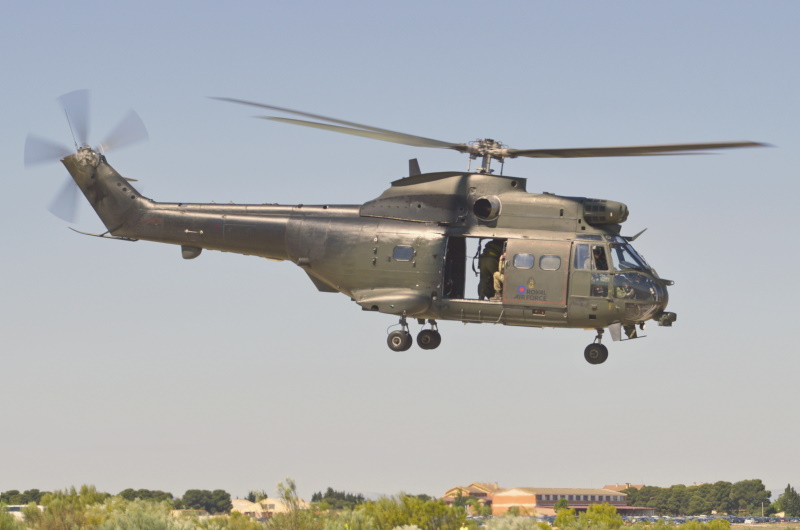
The British later set up an upgrade program to bring 24 Puma HC.1 rotorcraft to "Puma HC.2" standard, the first machine being redelivered in 2012. The Mark 2 features a modern glass cockpit, updated defensive countermeasures, a digital automatic flight control system, secure communications, ballistic armor, larger fuel tanks, and Turbomeca Makila 1A1 engines with 1,325 kW (1,780 SHP) each. The HC.2 is capable of hauling twice the payload of the HC.1 over three times the range.
Along with the SA 330B, an "SA 330C" was built for the export market, much like the SA 330B but with more powerful Turbomeca Turmo IVB engines providing 1,045 kW (1,400 SHP) each. The SA 330C was sold, generally in small numbers, to about a dozen countries -- export use of the Puma series is discussed below. There was consideration of an "SA 330D" variant for the British Royal Navy, to be used in the SAR role, but the Royal Navy acquired the Sikorsky / Westland S-61 Sea King, freeing up the Westland Whirlwind and Wessex -- a license-built turboshaft version of Sikorsky H-34 / S-58 -- for SAR duties, and the SA 330D didn't happen.
An "SA 330F" was also offered for the civil market, this variant featuring Turmo IVA engines, with 1,070 kW (1,435 SHP) each -- somewhat counter-intuitively, the Turmo IVA was more powerful than the Turmo IVB. Inlet deicing was standard, with the sliding doors replaced by airliner-type doors featuring retractable "air stairs", plus seating for up to 21 passengers and options for niceties like air-conditioning. Despite its focus on the civil market, the SA 330F was also bought by a number of military forces.
* Aerospatiale superseded Sud Aviation in 1970, with the Puma remaining an important product for the re-badged company. In 1974, introduction of the Turmo IVC powerplant, with 1,175 kW (1,575 SHP), permitted an increase of maximum take-off weight by about 15% and an increase in speed by about 5%, with correspondingly better "hot and high" performance. Two main variants were introduced with the more powerful engines:
AA SA 330Ba machines were modified into several specialized subvariants:
Composite main rotors were introduced in 1977, the rotors featuring a fiberglass spar; a polyurethane honeycomb core; skin made of fiberglass and carbon-fiber fabric; and a protective leading-edge strip of stainless steel. The new blades were much more corrosion-resistant than the old metal blades. With the new main rotors, the civil SA 330G become the "SA 330J" and the military SA 330H becoming the "SA 330L".
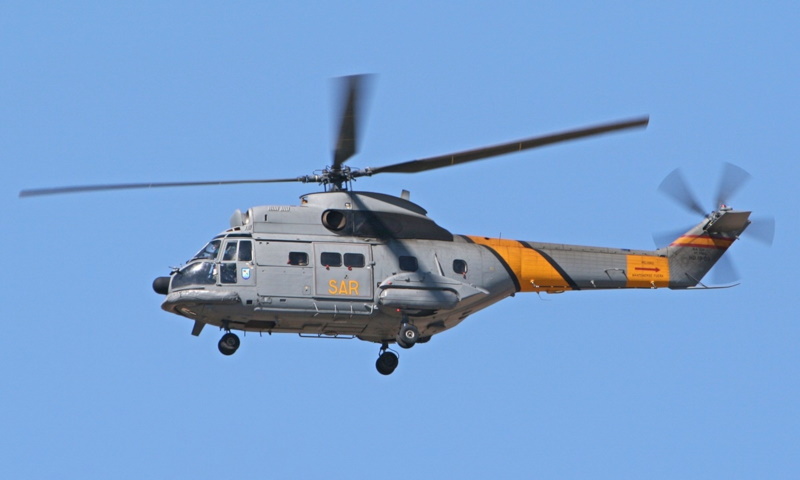
As mentioned, most of the original RAF HC.1 Pumas were retrofitted with the composite blades; about 40% of the ALAT Pumas were also updated with the new blades.
___________________________________________________________________
AEROSPATIALE SA 330L PUMA:
___________________________________________________________________
main rotor diameter:
15 meters (49 feet 2 inches)
tail rotor diameter:
3.04 meters (10 feet)
fuselage length:
14.06 meters (46 feet 2 inches)
footprint length:
18.15 meters (59 feet 6 inches)
height (tail rotor):
5.14 meters (16 feet 11 inches)
height (rotor head):
4.38 meters (14 feet 4 inches)
empty weight:
3,615 kilograms (7,970 pounds)
max loaded weight:
7,500 kilograms (16,535 pounds)
maximum cruise speed:
265 KPH (165 MPH / 145 KT)
service ceiling:
6,000 meters (19,685 feet)
hover ceiling (in ground effect):
4,400 meters (14,435 feet)
hover ceiling (out of ground effect):
4,250 meters (13,940 feet)
range:
570 kilometers (355 MI / 310 NMI)
___________________________________________________________________
* Aerospatiale ceased production of the Puma in 1987, with 697 sold, the company moving on to improved derivatives from that time. However, in 1974 the ICA (later IAR) firm of Brasov, Romania, had signed a license deal with Aerospatiale to build the SA 330L variant, locally designated the "IAR-330L". The first Romanian-built machine performed its initial flight in 1975; production began in 1977, with 104 delivered to Romanian forces and about 60 more sold to export users.
Romanian machines could be fitted up as gunships, with twin 20-millimeter cannon under the nose and stores on outriggers, such as four unguided rocket pods, usually 16-round 57-millimeter rocket pods, or AT-3 Sagger antitank guided missiles. By the 1990s, the IAR-330L was getting a bit behind the times for the demanding battlefield support role, and so in 1992 the Romanian Air Force launched the "Puma 2000" program to update the type.
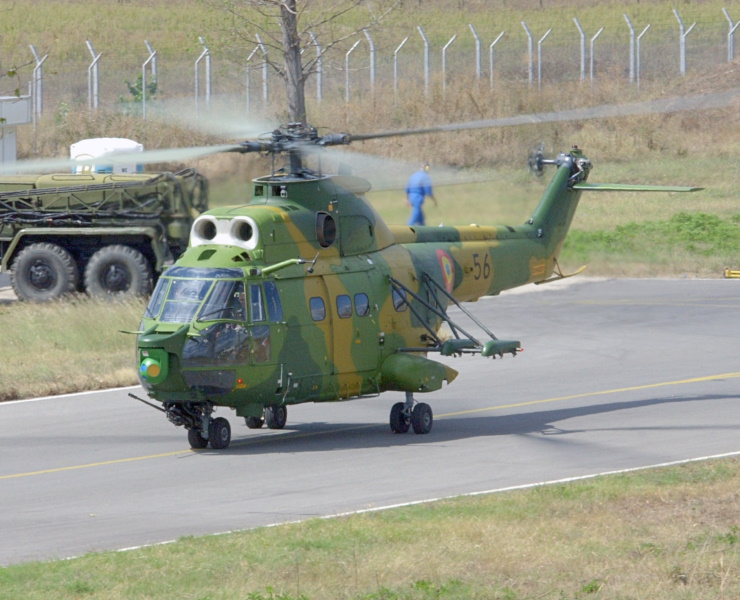
The upgrade was implemented with help from Elbit of Israel, with 24 machines upgraded from 1995 to IAR-330 SOCAT configuration, the SOCAT acronym standing for "Optical Electronic Reconnaissance & Anti-Armor System". The SOCAT upgrade featured a new cockpit, most significantly with "hands on collective and stick (HOCAS)" controls; an imaging turret in the nose, with a datalink to relay imagery to ground forces; a GIAT (now Nexter) 20-millimeter cannon under the nose; and pylons for carriage of four unguided rocket pods or eight Rafael Spike anti-armor missiles. Initial flight of the SOCAT was in 1998, with first delivery in 2001 and last delivery in 2005. Three navalized IAR-330 SOCATs with flotation gear were provided to the Romanian Navy from 2007.
In the early 1980s, IPTN of Indonesia also assembled eleven SA 330J machines from French-supplied knockdown kits. The SA 330 series proved popular in export sales. Aside from Britain, France, and Romania, European users included:
African users included:
Middle Eastern users included:
Asian users included:
Latin American users included:
Some of these users obtain Romanian-built IAR-330Ls. One SA 330J was even used for trials by the US Navy, but the Puma was never adopted into US military service.
BACK_TO_TOP* From 1974, Aerospatiale began to consider an improved derivative of the Puma, with the initial flight of the first of six prototypes of what was originally known as the "AS332 Super Puma" taking place on 13 September 1978 -- "AS" of course standing for "Aerospatiale". The AS332 featured the new fiberglass rotors and more powerful Turbomeca Makila 1A engines providing 1,325 kW (1,780 SHP) each; the Makila engines were also more compact and had about 18% better fuel economy. The new engines had been trialed in an SA 330 from a year earlier. The AS332 featured other changes as well, including:
The AS332 was mostly targeted at civil users, with interior accommodations improved accordingly, but it also had features useful for military users, such as a damage-resistant gearbox hub. The composite blades were also more resistant to projectile strikes than the old metal blades, and Aerospatiale offered product options for military customers: armored crew seats, crashworthy crew seats, sensor systems, defensive countermeasures systems, and various armament.
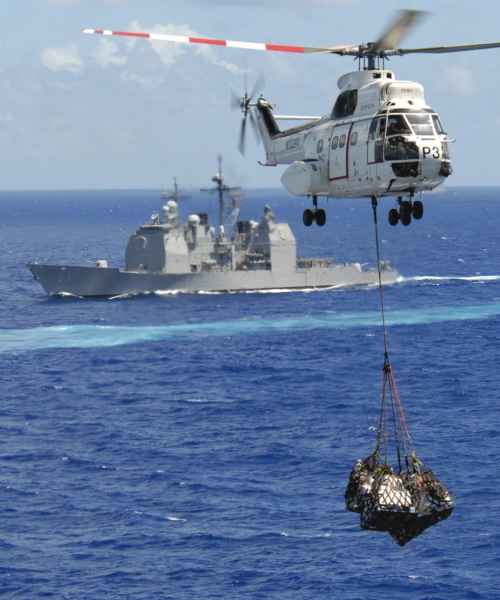
The Super Puma entered service in 1981. Two variants were initially produced, including the military "AS332B" and the civil "AS332C". Upgrades to Makila power were also offered to existing SA 330 users -- though it appears Portugal was one of the few operators to take Aerospatiale up on the offer, with a handful of SA 330C machines upgraded to "SA 330S" standard.
___________________________________________________________________
AEROSPATIALE SA 332B SUPER PUMA (AS532 UC COUGAR)
___________________________________________________________________
main rotor diameter:
15.6 meters (51 feet 2 inches)
tail rotor diameter:
3.05 meters (10 feet)
fuselage length:
15.53 meters (51 feet)
footprint length:
18.7 meters (61 feet 2 inches)
height (tail rotor):
4.92 meters (16 feet 11 inches)
height (rotor head):
4.6 meters (15 feet 1 inch)
empty weight:
4,330 kilograms (9,545 pounds)
max loaded weight:
9,350 kilograms (20,615 pounds)
maximum cruise speed:
265 KPH (165 MPH / 145 KT)
service ceiling:
4,100 meters (13,450 feet)
hover ceiling (1):
2,700 meters (8,860 feet)
hover ceiling (2):
1,600 meters (5,250 feet)
range:
620 kilometers (385 MI / 335 NMI)
___________________________________________________________________
* The greater power of the Makila turboshafts permitted airframe growth, and so in 1982 Aerospatiale introduced a "stretched" Super Puma, with the fuselage extended by 76 centimeters (30 inches), from 15.53 meters (51 feet) to 16.29 meters (53 feet 6 inches). The new stretched fuselage permitted carriage of four more passengers; a prominent large window was added on each side of the fuselage plug, just behind the cockpit, providing a distinctive recognition feature.
Initial production variants included the military "AS332M" and civil "AS332L". The earlier AS332B and AS332C remained in production in parallel, with a navalized model, the "AS332F", being offered in SAR / maritime patrol configurations or for maritime combat / ASW. The navalized models featured a folding tailboom, inflatable flotation bags, and shipboard deck tiedown gear.
___________________________________________________________________
AEROSPATIALE SA 332M SUPER PUMA (AS532UL COUGAR)
___________________________________________________________________
main rotor diameter:
15.6 meters (51 feet 2 inches)
tail rotor diameter:
3.05 meters (10 feet)
fuselage length:
16.29 meters (53 feet 6 inches)
footprint length:
18.7 meters (61 feet 2 inches)
height (tail rotor):
4.92 meters (16 feet 2 inches)
height (rotor head):
4.6 meters (15 feet 1 inch)
empty weight:
4,460 kilograms (9,830 pounds)
max loaded weight:
9,350 kilograms (20,615 pounds)
maximum cruise speed:
265 KPH (165 MPH / 145 KT)
service ceiling:
4,100 meters (13,450 feet)
hover ceiling (in ground effect):
2,700 meters (8,860 feet)
hover ceiling (out of ground effect):
1,600 meters (5,250 feet)
range:
840 kilometers (525 MI / 455 NMI)
___________________________________________________________________
In early 1990, Aerospatiale performed a marketing "facelift" on the product line, with the military offerings being given the designation of "AS532 Cougar", featuring a Chinese menu of variants:
No long-fuselage naval variants were offered. The armed Army variants could carry machine guns and unguided rocket pods, while the AS532SC could carry homing torpedoes or the Exocet antiship missile. The civil line remained the AS332L Super Puma, updated in the form of the "AS332L1".
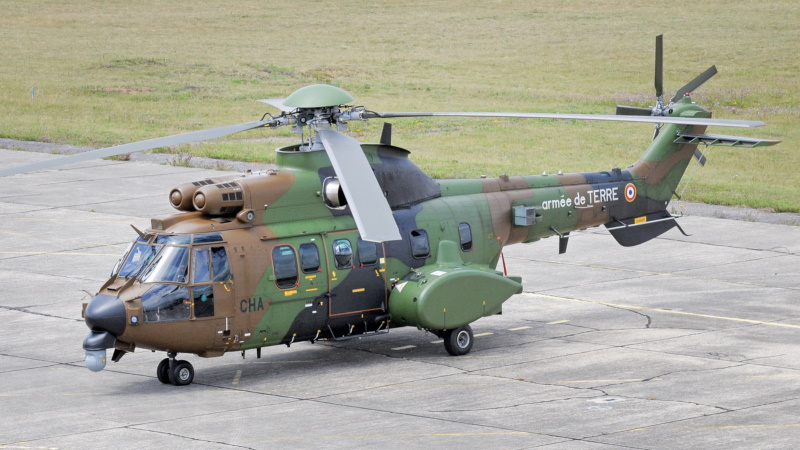
Following the success of the ORCHIDEE Puma in the Gulf War, in the late 1990s the ALAT obtained four AS532 UL Cougars with a deployable antenna for an I-band radar under the rear fuselage, with the program being known as "HORIZON" for "Helicoptere d'Observation Radar et d'Investigation sur Zone".
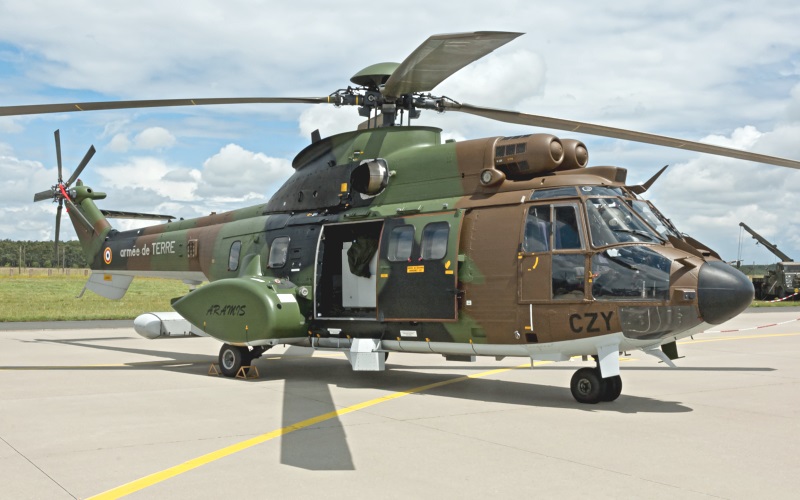
* As with the SA 330, the Super Puma / Cougar proved popular in export sales:
The original Super Puma / Cougar remains in production, "AS322 L1e" being introduced in 2012 that featured the glass cockpit and autopilot from the H225, that machine being described below. The 1,000th Super Puma was delivered in 2019. It remains in widespread service, with many Super Pumas / Cougars remaining in service having been upgraded with modernized avionics. However, the type is now in decline, gradually being replaced by more modern types. The French Army plans to withdraw the last of its Super Pumas in 2025.
BACK_TO_TOP* Aerospatiale continued to extend the Puma / Cougar line, performing the first flight of the "AS532 Cougar Mark II" on 6 February 1987. The Cougar Mark II featured further uprated Makila 1A2 turboshafts providing 1,570 kW (2,105 SHP) each and another fuselage stretch, this time of 55 centimeters (21.5 inches), providing space for a total of 28 passengers.
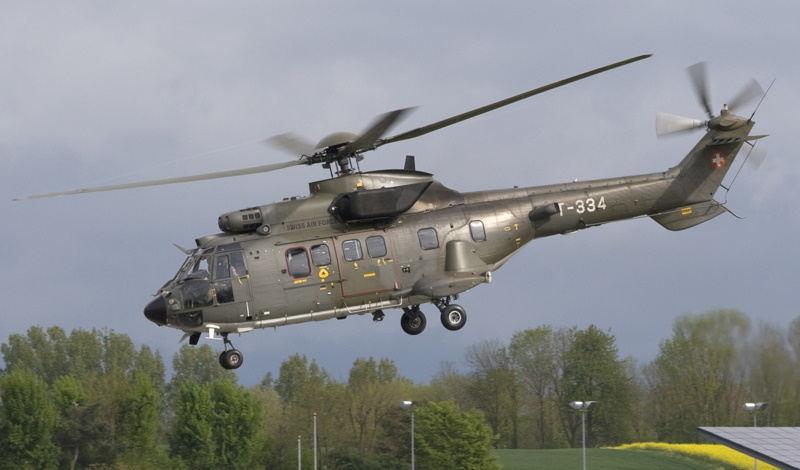
The "Cougar AS532U2 Mk.II" entered service in 1992, with a civil version, the "AS332L2 Super Puma 2", produced in parallel.
___________________________________________________________________
AEROSPATIALE (AIRBUS HELICOPTER) AS532U2 COUGAR MK.II:
___________________________________________________________________
main rotor diameter:
16.2 meters (53 feet 2 inches)
tail rotor diameter:
3.15 meters (10 feet 4 inches)
fuselage length:
16.74 meters (54 feet 11 inches)
footprint length:
19.5 meters (63 feet 11 inches)
height (tail rotor):
4.97 meters (16 feet 4 inches)
height (rotor head):
4.6 meters (15 feet 1 inch)
empty weight:
4,760 kilograms (10,495 pounds)
max loaded weight:
9,500 kilograms (20,945 pounds)
maximum cruise speed:
275 KPH (170 MPH / 150 KT)
service ceiling:
4,100 meters (13,450 feet)
hover ceiling (in ground effect):
2,540 meters (8,335 feet)
hover ceiling (out of ground effect):
1,900 meters (6,235 feet)
range:
795 kilometers (495 MI / 430 NMI)
___________________________________________________________________
* In the early 1990s, Aerospatiale's helicopter operation was consolidated with Messerschmitt-Boelkow-Blohm of Germany to form the "Eurocopter" group, which would later become part of the "European Aerospace & Defense Systems (EADS)" group. In 2014, EADS became the "Airbus Group", with Eurocopter becoming the "Airbus Helicopter" division; the 21st-century name is used here for simplicity. Airbus Helicopter went on to continue to refine the Puma design.
In the late 1990s, the AA issued a requirement for an improved RESCO helicopter, and in response Airbus Helicopter came up with a modified Cougar Mk.II for the job. The AA wanted something a little more capable, however, and so Airbus Helicopter came up with a refined "Mk.II+" configuration, with initial flight at Marignane on 27 November 2000. The Mk.II+ featured:
In comparison to the Mk.II, the improved powerplants gave the Mk.II+ an increased lift capacity of 900 kilograms (1,800 pounds), an increase in speed of 41 KPH (25 MPH), and an increase in range of 272 kilometers (169 miles). The Mk.II+ went into production for military use as the "EC725 Caracal" -- where of course "EC" stood for "Eurocopter", that label now being obsolete -- along with a civil version, the "EC225 Super Puma Mk.II+". In 2015, these designations became the "H225M" and "H225" respectively.
The Caracal went into service with the AA in 2005, the variant being configured with an inflight refueling probe, the first French-built helicopter with such a feature. The probe could be removed or installed in a half hour. The AA Caracals also had provisions for removeable armor, and were fitted with cable cutter blades, defensive countermeasures, plus a FLIR camera turret. A rescue winch was fitted in the left door, along with a domed window to allow the rescue crew to see downward. Armament options included a pintle-mounted 7.62-millimeter FN MAG machine gun on each side, unguided rocket pods, or 20-millimeter cannon pods.
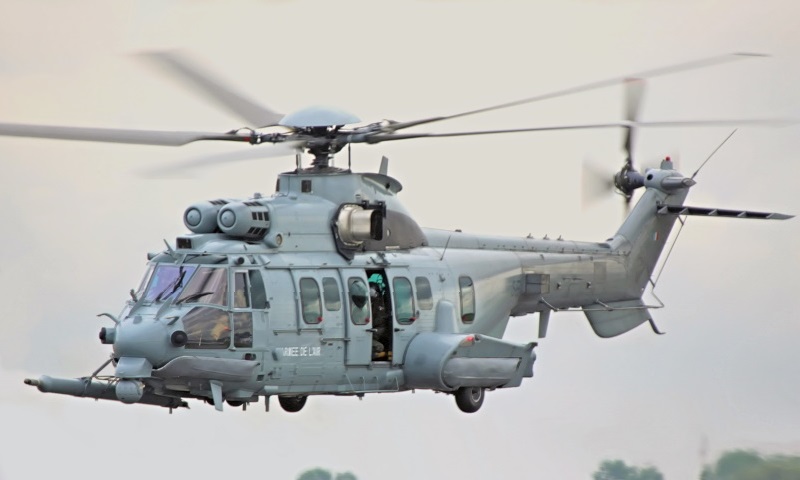
The French military has apparently obtained a dozen Caracals, presumably all in the CSAR / RESCO format, with the type seeing service in Afghanistan. French CSAR Caracals have been "up-gunned" with a 20-millimeter cannon or Herstal M3M 12.7-millimeter machine gun on flexible mounts. Unsurprisingly, Airbus Helicopter also offers troop transport, VIP transport, and casualty evacuation configurations -- the last with provisions for 12 stretchers and 4 medical attendants. In 2016, Airbus also introduced the "HForce" armament package for their military helicopters, featuring a fire control system processor, helmet-mounted sight, sighting turret, and carriage of gun and missile pods.
The H225M is being license-built by Helibras of Brazil, with Brazilian forces to obtain 50 machines as the "HM.4 Jaguar". The first three were delivered in late 2010, these helicopters being assembled from knock-down kits supplied from France, with later production to feature increasing local content. They were eventually updated to carry Exocet antiship missiles. From 2018, production was also performed in Romania. Along with new-build production, there have also been upgrades of earlier Puma-Cougar variants to H225 / H225M configuration.

Other users who have obtained the type include Hungary, Indonesia, Kazakhstan, Kuwait, Malaysia, Mexico, Singapore, Thailand, and Ukraine, while a number of civil users have obtained the H225. There was talk from the late 1990s of a "Mark III" variant of the Puma family, but the concept seems to have gone cold. The bigger Puma variants apparently end up competing in the market niche with newer helicopters in the same size class, and the prospect of sales is poor.
Airbus had been planning a successor to the Super Puma, the "X6", publicly launched at the Paris Air Show in 2015. It was to be a completely new design, featuring composite construction, a low-noise rotor system, and a fly-by-wire control system. Development was suspended in 2018, due to shifting market conditions, and continued good sales of the H225 / H225M.
BACK_TO_TOP* The Puma / Cougar has a South Korean relative, the Korean Aerospace Industries (KAI) "KUH-1 Surion (Perfect Eagle)". In 2005, the Korean government issued a request for proposals for a new "light utility helicopter (LUH)" to replace aging Bell UH-1 Hueys in South Korean service. Helicopter firms from all over the world submitted proposals, with the award given to a collaboration of KAI and Airbus Helicopter. The "Korean Helicopter Program (KHP)" was formally launched the next year. The initial prototype of the Surion LUH was rolled out in July 2009, performing its initial flight in March 2010. Production deliveries to the Republic of Korea Army (ROKA) began in 2012, with 245 machines to be delivered over the next decade.

As it emerged, the Surion clearly appeared to be a member of the Puma-Cougar family. However, although Airbus Helicopter did provide the dynamic system and an automatic flight control system for the helicopter, it is unclear if the Surion had much other relationship to the Puma-Cougar, or if the Airbus Helicopter designs were simply seen as an inspiration. The Surion was of conventional main-tail rotor configuration, powered by twin turboshafts on top of the fuselage, and with wheeled fixed tricycle landing gear.
The Surion was powered by twin General Electric T700-ST-701C engines, built under license by Samsung and each providing 1,380 kW (1,850 SHP), with large exhaust IR suppressor boxes derived from those fitted to the H225. The avionics system featured a glass cockpit, accommodating helmet-mounted displays. Other avionics included a GPS-INS unit, health and usage monitoring system, and defensive countermeasures. It could carry six TOW anti-armor missiles, or unguided rocket packs. The Surion crew included a pilot, a copilot, two gunners, and nine troops, or sixteen troops if no door gunners were included. Of course, it could also be kitted up for the medevac mission, with six stretchers, a medical attendant, medical support kit, and a rescue hoist.
___________________________________________________________________
KAI SURION:
___________________________________________________________________
main rotor diameter:
15.8 meters (51 feet 10 inches)
tail rotor diameter:
3.15 meters (10 feet 6 inches)
fuselage length:
15.09 meters (49 feet 6 inches)
footprint length:
19 meters (62 feet 4 inches)
height:
4.5 meters (14 feet 10 inches)
empty weight:
4,975 kilograms (10,960 pounds)
loaded weight:
8,710 kilograms (19,200 pounds)
cruise speed:
260 KPH (160 MPH / 140 KT)
service ceiling:
3,000 meters (9,850 feet)
range:
480 kilometers (300 MI / 260 NMI)
___________________________________________________________________
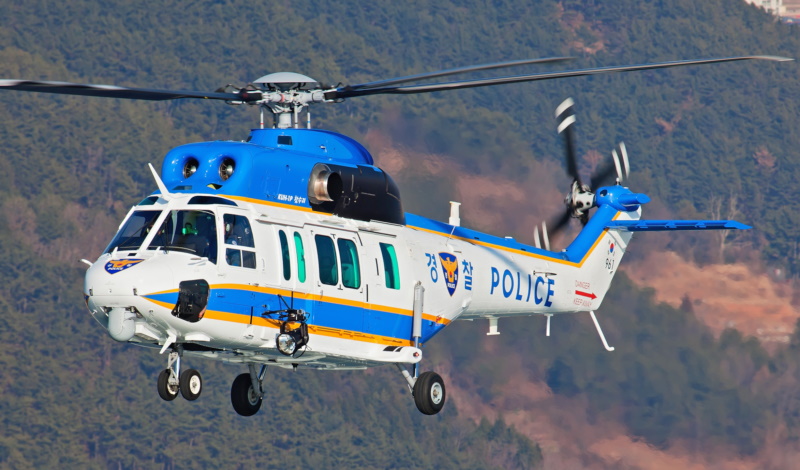
A civil police version has been developed and is in service, this variant being designated the "KUH-1P Chamsuri". Work is underway for a "Marine Attack Helicopter (MAH)" for the ROK Marines; it features an under-nose 20-millimeter Gatling cannon in a turret.
BACK_TO_TOP* The following list summarizes Puma family production:
* Sources include:
* Illustration credits:
* Revision history:
v1.0.0 / 01 jul 10 v1.1.0 / 01 sep 10 / Quick corrective update. v1.2.0 / 01 feb 11 / Deleted EC 175, add details on SOCAT upgrade. v1.2.1 / 01 jan 13 / RAF Puma HC.2 redelivery, EC 725 buys. v1.3.0 / 01 dec 14 / Added KAI Surion. v1.3.1 / 01 nov 16 / Review & polish. v1.3.2 / 01 oct 18 / Designation changes, minor updates. v1.3.3 / 01 dec 20 / Review, update, & polish. v1.4.0 / 01 dec 22 / Illustrations update. v1.4.1 / 01 aug 23 / Review & polish.BACK_TO_TOP
